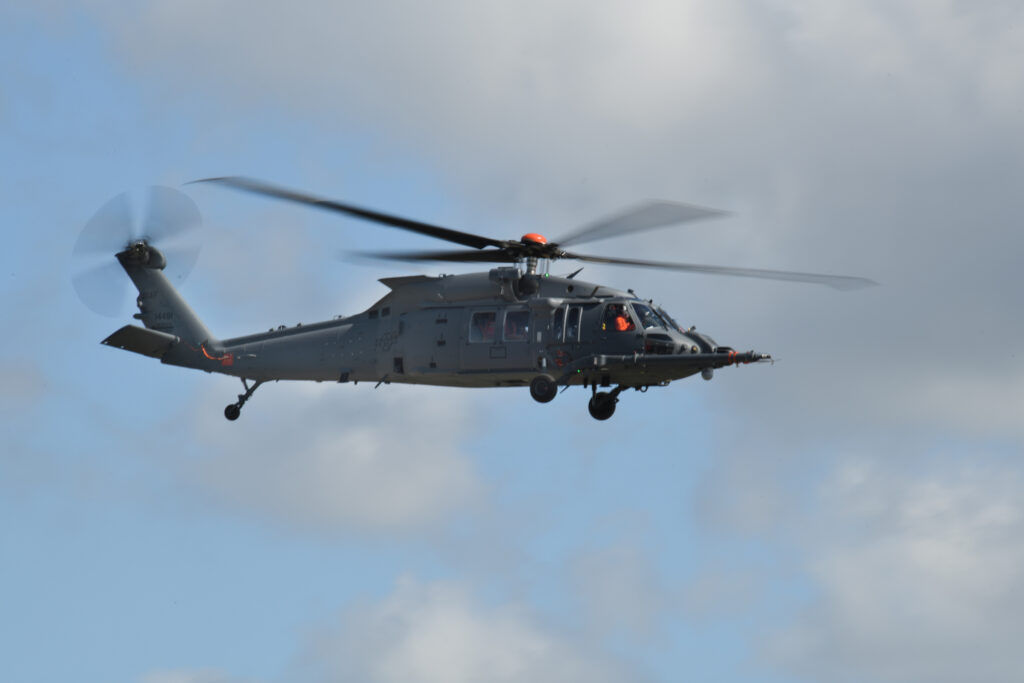Sikorsky Races To Deliver Rescue Helo On Time
Posted on

HH-60W Combat Rescue Helicopter during a test flight
JUPITER, FLA: The Air Force’s new Combat Rescue Helicopter made its first flight less than six weeks ago, more than seven months late, but manufacturer Sikorsky swears they now have the much-delayed HH-60W back on schedule.
Their deadline: a critical Pentagon review this coming September, a so-called Milestone C, that will determine whether the program can proceed to Low-Rate Initial Production of the first 22 aircraft, of a planned 113. The new choppers are urgently needed to replace aging HH-60G Pave Hawks, used hard in Afghanistan and Iraq, that the Air Force has been trying to replace since the CSAR-X debacle of 2009.
“We’re back on the contract schedule,” Sikorsky program director Greg Hames told reporters visiting the company’s test site here outside of West Palm Beach.
At one point last year, Hames, admitted, the program was falling one week behind with every week that passed. In December, a report from the Pentagon’s independent Director of Operational Test & Evaluation (DOT&E) prompted a come-to-Jesus moment when the program totally overhauled its approach.
Since then, “we have beat every single commitment to the government and we are working with a two-week buffer,” Hames said, proudly pointing to charts of one met deadline after another. “In six months, we have pulled back five.”
How? The company isn’t skipping any steps, Hames emphasized: The Air Force will have all the data it needs to make a decision in September.

The first HH-60W Combat Rescue Helicopters at Sikorsky’s Florida test site.
Sikorsky has two aircraft now in testing, with one or the other flying five days a week. If you count on working through the weekend, Hames said, you have no margin for when something inevitably goes wrong. So the weekend and holidays are reserved for make-up flights in the event of malfunction, bad weather, or other problems.
The company’s Stratford factory has delivered two more aircraft to the Florida test site, where they’re being rigged with the extensive instrumentation required for test flights expected to start this August. Each individual helicopter is instrumented differently to test a specific set of features, such as avionics.
The H-60 helicopter is a proven military workhorse and Sikorsky’s most famous product, so there’s not as much testing as there would be for an all-new aircraft. The Air Force HH-60W “Whiskey” specifically derives from the Army’s latest model, the UH-60M “Mike” Black Hawk. The two variants share such upgrades as a digitized cockpit that reduces dozens of different controls to five multi-function touchscreens. But the 60W has a lot more systems to integrate into those controls than the 60M did.
Why? As a combat search-and-rescue aircraft, the 60W has to go wherever Air Force pilots are shot down, and that usually means well inside hostile territory. This wasn’t such a problem fighting guerrillas in Afghanistan and Iraq, where the enemy rarely had the technology to bring down US aircraft, especially high-flying jets, and US airpower could easily reach and dominate any crash site. But hostile nation-states like Iran and Syria have advanced Russian-made anti-aircraft systems, while Russia and China themselves have even more dangerous defenses. That increases the risk to both strike pilots and to the rescue helicopters supporting them.
So the 60W has a radar warning receiver, a targeting-laser detector, hostile-fire detector, and other self-defense features more advanced and extensive than those on the aging HH-60G Pave Hawk it will replace. In case those features fail to ensure the enemy misses, it also has more armor.
All these extra features add weight, so the aircraft needs more fuel to cover the same distance — and rescue helicopters often have to go further than regular H-60s supporting friendly forces anyway. To cope, the 60W has much larger internal fuel tanks than the 60G, which often had to carry external tanks whose drag slowed the helicopter down. Both the W and G also have a built-in boom for aerial refueling, something standard Black Hawks lack. Like the Army models, they routinely carry weapons.
But the big difference is age and wear. The hard-used 60Gs were already starting to break down in 2007, when Hames’ partner on the program, business developer Steve Colby, retired from flying them. Today, only 19 percent of the Pave Hawks are rated Fully Mission Capable — and Colby’s own son is flying the aging helicopters. “I’m hearing the laments from him and his friends,” he said: It’s past time to give them a new aircraft that actually works.
Subscribe to our newsletter
Promotions, new products and sales. Directly to your inbox.
